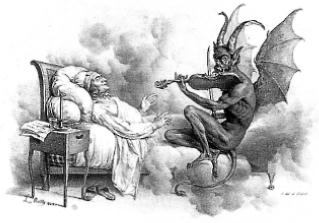




















o
|


 Featured on:
Featured on:
Tartini cdc 017
Tartini/Boccherini cdc 017/018
|
Tartini
and the violin, the violin and the Devil, the Devil and Tartini.
These connections are very widely in today’s general culture.
The link between Tartini and the violin arises because of
his great contribution to that instrument - an instrument
full of magic and devilry not least because of its special
identification with |
the
gypsies, a mysterious people of sorcery and charms, a race in part
Christian and in part pagan. Tartini’s name is linked to that of
the Devil because of that very famous "trillo".
 Tartini was
a troubled but dynamic man, both a great theorist and a great player.
He was a musician and composer who belonged to a period of transition,
to that changeover from the late Baroque to Classicism. His compositions
for the most part were Sonatas and Concertos, but only a hundred
or so (out of a total of about three hundred and fifty) were published
during his life-time. The Sonatas are structured along itentical
lines - an Adagio followed by two fast movements. The Concertos
are intricate and complicated in their first movements; the slow
middle section is evocative of song; and the final parts are lively
and fast. Tartini was
a troubled but dynamic man, both a great theorist and a great player.
He was a musician and composer who belonged to a period of transition,
to that changeover from the late Baroque to Classicism. His compositions
for the most part were Sonatas and Concertos, but only a hundred
or so (out of a total of about three hundred and fifty) were published
during his life-time. The Sonatas are structured along itentical
lines - an Adagio followed by two fast movements. The Concertos
are intricate and complicated in their first movements; the slow
middle section is evocative of song; and the final parts are lively
and fast.
 Tartini’s
works of musical theory are also worthy of note. His theory of the
"third sound" (or combination tones) was well expressed
in a number of publications: Tartini’s
works of musical theory are also worthy of note. His theory of the
"third sound" (or combination tones) was well expressed
in a number of publications:
- Trattato
di Musica secondo la vera scienza dell’Armonia (1754)
- De’
principi dell’armonia musicale nel diatonico genere (1767)
- Traite
des agrements (published posthumously in Paris in 1771)

© P&P - Promozione e Produzione, Rome.
|

